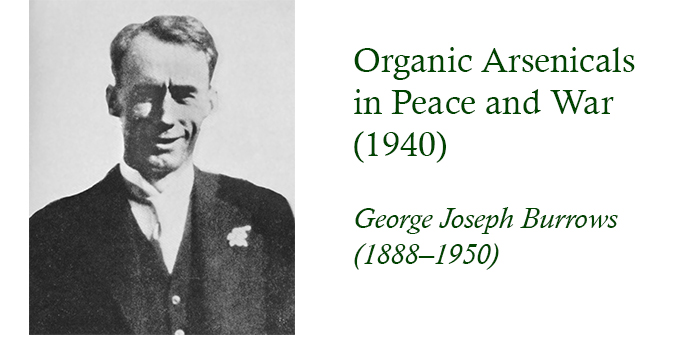3: Organic Arsenicals in Peace and War (1940)
Abstract
Liversidge Research Lecture delivered on October 29th at Science House, Sydney, arranged by the Royal Society under the terms of the Liversidge bequest. Reproduced by permission of the Royal Society of New South Wales from J. Proc. Roy. Soc. N.S.W., 1940, 74, M1–M16.
"I propose, in the short time at my disposal, to treat the subject rather from an academic viewpoint and to review briefly some of the methods available for the preparation of organic derivatives of arsenic. At the same time I will use for illustrations compounds which have been of service to man, either as agents of destruction or the reverse."
"Today there are many thousands of organic arsenicals known, a fact to be attributed to the ease with which carbon-arsenic linkages are formed and also to the stability of such linkages. Once an organic arsenical is prepared, it can be subjected to many diverse types of reaction to yield fresh derivatives without severing the C-As bond. Yet in spite of this ease of formation and stability, the vast number of organic arsenicals are almost exclusively products of the laboratory."
References
(1) Cahours and Riche: Ann., 1854, 92, 362.
(2) Cahours: Ann., 1859, 112, 228 ; 1862, 122, 207.
(3) Michaelis: Ber., 1876, 9, 1566.
(4) Michaelis and Schultz: Ber., 1881, 14, 912; 1882, 15, 1952. Michaelis and Schoefer: Ibid., 1913, 46, 1742.
(5) Grysz-Kiewiez-Trochemowski: Rocz. Chem., 1928, 8, 250.
(6) Cahours: Ann., 1860, 116, 367. Dehn: Am. Chem. J., 1905, 33, 126. Palmer and Dehn: Ber., 1901, 34, 3598.
(7) Meyer: Ber., 1883, 16, 1440. Klinger and Kreutz : Ann., 1888, 249, 149. Favrel: Bull. Sci. Pharmacol., 1913, 20, 337. Quick and Adams, J.A.C.S., 1922, 44, 805.
(8) Auger: Compt. Rend., 1906, 142, 1151.
(9) Burrows and Turner: J.C.S., 1920, 117, 1376.
(10) Burrows and Turner: Ibid., 1921, 119, 433.
(11) Burrows and Turner: Loc. cit.
(12) Steinkopf and Schwen: Ber., 1921, 54 (B), 1454.
(13) Lee, Thing and Dehn : J.A.C.S., 1923, 45, 2997.
(14) Palmer and Dehn Loc.cit . Dehn: Am.Chem.J.,1908,40,117.Williams:Ibid.,1908,40, 107.
(15) Palmer: Ber., 1894, 27, 1378. Dehn and Wilcox: Am. Chem. J., 1906, 35, 1.
(16) Dafert: Monat., 1919, 40, 313.
(17) Green and Price: J.C.S., 1921, 119, 448. Mann and Pope: Ibid.,1922, 121, 1754. Lewis and Stiegler: J.A.C.S., 1925, 47, 2546.
(18) Burrows and Turner: J.C.S., 1920, 117, 1382.
(19) Brit. Pat., 1918 (142880). Pope and Turner: J.C.S., 1920, 117, 1450. Morgan and Vining: Ibid., 1920, 117, 780.
(20) Michaelis: Ann., 1902, 321, 211, 226. Michaelis and Paetow. Ber., 1885, 18, 41. Michaelis and Weitz: Ibid., 1887, 20, 49.
(21) Bart: German Pat., 1912 (250264), (254092).
(22) Brit. Pat., 1919 (142947). Schmidt: Ann., 1920, 42., 159.
(23) Bart: Ann., 1922, 429, 100.
(24) Burrows and Turner: J.C.S., 1920, 117, 1373; 1921, 119, 426.
(25) Burrows and Turner: Loc. cit.
(26) Blicke and Smith: J.A.C.S., 1929, 51, 3479.
(27) Burrows: Proc. Roy. Soc. N.S.W., 1935, 68, 72.
(28) Burrows and Lench: Ibid., 1937, 70, 295.
(29) Burrows: Loc. cit.
(30) Burrows and Lench Loc. cit.
(31) Burrows and Turner: J.C.S., 1921, 119, 426.
(32) Wieland: Ann., 1923, 431, 30.
(33) Bayer and Co. German Pat. (1913), 281049. Wieland and Rheinheimer: Ann., 1921, 423, 1. Lewis and Hamilton: J.A.C.S., 1921, 43, 2281. Lewis, Lowry and Bergeim Ibid., p. 891. Gibson and others: J.C.S., 1924, 2277; 1926, 450, 464, 2241; 1927, 247, 2499; 1928, 2204.
(34) Mann and Pope: J.C.S., 1922, 121, 1754. Lewis and Stiegler: J.A.C.S., 1925, 47, 2546.
(35) Aeschlimaru: J.C.S., 1927, p.414.
(36) Lewis,Lowry and Bergein: J. Am. Chem. Soc., 1921, 43, 890. Turner and Sheppard: J.C.S. 1925, 127, 544.
(37) Turner and Lesslie: J.C.S., 1934, 1170; 1935, 1150, 1268.
(38) Kalb: Ann., 1921., 423, 39.
(39) Hamilton and Johnston: J. Am. Chem. Soc., 1926, 48, 1406. Conant: Ibid., 1919, 41, 431. Jacobs and Heidelberger: Ibid., 1440.
(40) Cheetham and Smith: J. Am. Chem. Soc., 1920, 42, 828.
(41) Benda and Bertheim: Ber., 1911, 44, 3445; J. Am. Chem. Soc., 1919, 41, 431. Bart: Ann., 1922, 429, 98. Karrer: Ber., 1913, 46, 515. Ismailski and Siminow: Journ. de Pharm. et de Chem., 22, 345.
(42) Raiziss and Gavron: J. Am. Chem. Soc., 1921, 43, 583.
(43) Bart: Ann., 1922, 429, 113. Ehrlich and Bertheim: Ber., 1912, 45, 756. Fargher and Pyman: J.C.S., 1920, 117, 376. Christiansen: J. Am., Chem. Soc., 1920, 42, 2402; 1921, 43, 370.
(44) German patents 245756, 263460, 264014, 271893.
(45) Voegtlin and Johnston: J. Am. Chem. Soc., 1922, 44, 2573. Jurist and Christiansen: J. Am. Chem. Soc., 1928, 50, 1911. Newbery and Phillips: J.C.S., 1928, 116. Christiansen: J. Am. Chem. Soc., 1933, 55, 4133.
(46) Burrows and Parker: J. Am. Chem. Soc., 1933, 55, 4133.
(47) Burrows and Parker: Proc. Roy. Soc. N.S.W., 1934, 68, 39.
(48) Anderson and Burrows: Ibid., 1936, 70, 63.
(49) Burrows and Sanford: Ibid., 1935, 69, 182.
(50) Burrows and Lench Ibid., 1936, 70, 218.
(51) Burrows and Lench Ibid., 1936, 70, 222.
(52) Burrows and Turner: J.C.S., 1920, 117, 1373.
(53) Mellor, Morris and Burrows: Nature, 1938, 141, 414.
(54) Burrows and Turner: J.C.S., 1921, 119, 436.
(55) Burrows and Turner: Loc. cit.
(56) Mills and Raper: J.C.S., 1925, 127, 2479.

